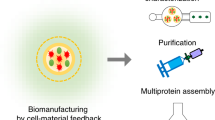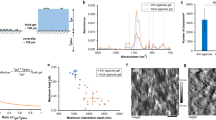Abstract
Bacteria deploy a range of chemistries to regulate their behaviour and respond to their environment. Quorum sensing is one method by which bacteria use chemical reactions to modulate pre-infection behaviour such as surface attachment. Polymers that can interfere with bacterial adhesion or the chemical reactions used for quorum sensing are therefore a potential means to control bacterial population responses. Here, we report how polymeric ‘bacteria sequestrants’, designed to bind to bacteria through electrostatic interactions and therefore inhibit bacterial adhesion to surfaces, induce the expression of quorum-sensing-controlled phenotypes as a consequence of cell clustering. A combination of polymer and analytical chemistry, biological assays and computational modelling has been used to characterize the feedback between bacteria clustering and quorum sensing signalling. We have also derived design principles and chemical strategies for controlling bacterial behaviour at the population level.
This is a preview of subscription content, access via your institution
Access options
Subscribe to this journal
Receive 12 print issues and online access
$259.00 per year
only $21.58 per issue
Buy this article
- Purchase on Springer Link
- Instant access to full article PDF
Prices may be subject to local taxes which are calculated during checkout




Similar content being viewed by others
References
Clatworthy, A. E., Pierson, E. & Hung, D. T. Targeting virulence: a new paradigm for antimicrobial therapy. Nature Chem. Biol. 3, 541–548 (2007).
Nathan, C. Fresh approaches to anti-infective therapies. Sci. Transl. Med. 4, 140sr2 (2012).
Hancock, R. E. W., Nijnik, A. & Philpott, D. J. Modulating immunity as a therapy for bacterial infections. Nature Rev. Microbiol. 10, 243–254 (2012).
Wei, P. et al. Bacterial virulence proteins as tools to rewire kinase pathways in yeast and immune cells. Nature 488, 384–388 (2012).
Klemm, P., Vejborg, R. M. & Hancock, V. Prevention of bacterial adhesion. Appl. Microb. Biotechnol. 88, 451–459 (2010).
Bricarello, D. A., Patel, M. A. & Parikh, A. N. Inhibiting host–pathogen interactions using membrane-based nanostructures. Trends Biotechnol. 30, 323–330 (2012).
Kaufmann, G. F., Park, J. & Janda, K. D. Bacterial quorum sensing: a new target for anti-infective immunotherapy. Exp. Opin. Biol. Ther. 8, 719–724 (2008).
Park, J. et al. Infection control by antibody disruption of bacterial quorum sensing signaling. Chem. Biol. 14, 1119–1127 (2007).
Hancock, R. E. W. & Sahl, H.-G. Antimicrobial and host–defense peptides as new anti-infective therapeutic strategies. Nature Biotechnol. 24, 1551–1557 (2006).
Nederberg, F. et al. Biodegradable nanostructures with selective lysis of microbial membranes. Nature Chem. 3, 409–414 (2011).
Liu, L. et al. Self-assembled cationic peptide nanoparticles as an efficient antimicrobial agent. Nature Nanotech. 4, 457–463 (2009).
Alexander, C., Pasparakis, G. & Cockayne, A. Control of bacterial aggregation by thermoresponsive glycopolymers. J. Am. Chem.Soc. 129, 11014–11015 (2007).
Shepherd, J. et al. Hyperbranched poly(NIPAM) polymers modified with antibiotics for the reduction of bacterial burden in infected human tissue engineered skin. Biomaterials 32, 258–267 (2011).
Lee, D-W., Kim, T., Park, I-S., Huang, Z. & Lee, M. Multivalent nanofibers of a controlled length: regulation of bacterial cell agglutination. J. Am. Chem. Soc 134, 14722–14725 (2012).
Rai, P. et al. Statistical pattern matching facilitates the design of polyvalent inhibitors of anthrax and cholera toxins. Nature Biotechnol. 24, 582–586 (2006).
Piletska, E. V. et al. Attenuation of Vibrio fischeri quorum sensing using rationally designed polymers. Biomacromolecules 11, 975–980 (2010).
Bush, K. et al. Tackling antibiotic resistance. Nature Rev. Microbiol. 9, 894–896 (2011).
Garner, A. L. et al. A multivalent probe for AI-2 quorum-sensing receptors. J. Am. Chem. Soc. 133, 15934–15937 (2011).
Cossart, P. & Sansonetti, P. J. Bacterial invasion: the paradigms of enteroinvasive pathogens. Science 304, 242–248 (2004).
Hook, A. L. et al. Combinatorial discovery of polymers resistant to bacterial attachment. Nature Biotechnol. 30, 868–875 (2012).
Smith, R. S. et al. Vascular catheters with a nonleaching poly-sulfobetaine surface modification reduce thrombus formation and microbial attachment. Sci. Transl. Med. 4, 153ra132 (2012).
Epstein, A. K., Wong, T.-S., Belisle, R. A., Boggs, E. M. & Aizenberg, J. Liquid-infused structured surfaces with exceptional anti-biofouling performance. Proc. Natl Acad. Sci. USA 109, 13182–13187 (2012).
Kastrup, C. J. et al. Spatial localization of bacteria controls coagulation of human blood by ‘quorum acting’. Nature Chem. Biol 4, 742–750 (2008).
Carnes, E. C. et al. Confinement-induced quorum sensing of individual Staphylococcus aureus bacteria. Nature Chem. Biol. 6, 41–45 (2010).
Alberghini, S. et al. Consequences of relative cellular positioning on quorum sensing and bacterial cell-to-cell communication. FEMS Microbiol. Lett. 292, 149–161 (2009).
Goryachev, A. B. Understanding bacterial cell–cell communication with computational modeling. Chem. Rev. 111, 238–250 (2011).
Flickinger, S. T. et al. Quorum sensing between Pseudomonas aeruginosa biofilms accelerates cell growth. J. Am. Chem. Soc. 133, 5966–5975 (2011).
Boedicker, J. Q., Vincent, M. E. & Ismagilov, R. F. Microfluidic confinement of single cells of bacteria in small volumes initiates high-density behavior of quorum sensing and growth and reveals its variability. Angew. Chem. Int. Ed. 48, 5908–5911 (2009).
Lowery, C. A., Dickerson, T. J. & Janda, K. D. Interspecies and interkingdom communication mediated by bacterial quorum sensing. Chem. Soc. Rev. 37, 1337–1346 (2008).
Atkinson, S. & Williams, P. Quorum sensing and social networking in the microbial world. J. R. Soc. Interface 6, 959–978 (2009).
Miller, M. B. & Bassler, B. L. Quorum sensing in bacteria. Annu. Rev. Microbiol. 55, 165–199 (2001).
Camilli, A. & Bassler, B. L. Bacterial small-molecule signaling pathways. Science 311, 1113–1116 (2006).
Williams, P. Quorum sensing, communication and cross-kingdom signaling in the bacterial world. Microbiology 153, 3923–3938 (2007).
Williams, P., Winzer, K., Chan, W. C. & Camara, M. Look who's talking: communication and quorum sensing in the bacterial world. Phil. Trans. R. Soc. B 362, 1119–1134 (2007).
Antunes, L. C. M. & Ferreira, R. B. R. Intercellular communication in bacteria. Crit. Rev. Microbiol. 35, 69–80 (2009).
Fuqua, C. & Greenberg, E. P. Listening in on bacteria: acyl-homoserine lactone signaling. Nature Rev. Mol. Cell Biol. 3, 685–695 (2002).
Redfield, R. J. Is quorum sensing a side effect of diffusion sensing? Trends Microbiol. 10, 365–370 (2002).
Federle, M. J. & Bassler, B. L. Interspecies communication in bacteria. J. Clin. Invest. 112, 1291–1299 (2003).
Xue, X. et al. Synthetic polymers for simultaneous bacterial sequestration and quorum sense interference. Angew. Chem. Int. Ed. 50, 9852–9856 (2011).
Barnard, A. M. L. et al. Quorum sensing, virulence and secondary metabolite production in plant soft-rotting bacteria. Phil. Trans. R. Soc. B 362, 1165–1183 (2007).
Fineran, P. C., Slater, H., Everson, L., Hughes, K. & Salmond, G. P. C. Biosynthesis of tripyrrole and beta-lactam secondary metabolites in Serratia: integration of quorum sensing with multiple new regulatory components in the control of prodigiosin and carbapenem antibiotic production. Mol. Microbiol. 56, 1495–1517 (2005).
Kenawy, E.-R., Worley, S. D. & Broughton, R. The chemistry and applications of antimicrobial polymers: a state-of-the-art review. Biomacromolecules 8, 1359–1384 (2007).
Engler, A. C. et al. Emerging trends in macromolecular antimicrobials to fight multi-drug-resistant infections. Nano Today 7, 201–222 (2012).
Winson, M. K. et al. Construction and analysis of luxCDABE-based plasmid sensors for investigating N-acyl homoserine lactone-mediated quorum sensing. FEMS Microbiol. Lett. 163, 185–192 (1998).
Swift, S. et al. Quorum sensing in Aeromonas hydrophila and Aeromonas salmonicida: identification of the LuxRI homologs AhyRI and AsaRI and their cognate N-acylhomoserine lactone signal molecules. J. Bacteriol. 179, 5271–5281 (1997).
Pearson, J. P. et al. Structure of the autoinducer required for expression of Pseudomonas aeruginosa virulence genes. Proc. Natl Acad. Sci. USA 91, 197–201 (1994).
Winson, M. K. et al. Multiple N-acyl-L-homoserine lactone signal molecules regulate production of virulence determinants and secondary metabolites in Pseudomonas aeruginosa. Proc. Natl Acad. Sci. USA 92, 9427–9431 (1995).
Diggle, S. P. et al. The Pseudomonas aeruginosa 4-quinolone signal molecules HHQ and PQS play multifunctional roles in quorum sensing and iron entrapment. Chem. Biol. 14, 87–96 (2007).
Pesci, E. C. et al. Quinolone signaling in the cell-to-cell communication system of Pseudomonas aeruginosa. Proc. Natl Acad. Sci. USA 96, 11229–11234 (1999).
Krasnogor, N. et al. An appealing computational mechanism drawn from bacterial quorum sensing. Bull. Eur. Assoc. Theor. Comput. Sci. 85, 135–148 (2005).
Acknowledgements
The authors acknowledge the UK Engineering and Physical Sciences Research Council and Biotechnology and Biological Sciences Research Council (grants EP/G042462/1, EP/H005625/1, EP/D022347/1, EP/D021847/1, EP/I031642/1, EP/J004111/1 and BB/F01855X/1) and the University of Nottingham for funding. The authors thank B. Bassler (Department of Molecular Biology, Princeton University) for the gift of V. harveyi and P. Williams and S. Diggle (University of Nottingham) for the gift of E. coli and P. aeruginosa strains. The authors also thank colleagues at SynBioNT (www.synbiont.net) for helpful discussions, and in particular B. Davis and L. Cronin for their advice and suggestions in the wider SynBioNT collaboration.
Author information
Authors and Affiliations
Contributions
All authors conceived and designed the experiments, analysed the data and discussed the results. N.K. and C.A. secured funding, X.X., C.S., A.B., L.L. and F.F-T performed the experiments and L.L., F.F-T., N.K. and C.A. co-wrote the manuscript.
Corresponding authors
Ethics declarations
Competing interests
The authors declare no competing financial interests.
Supplementary information
Supplementary information
Supplementary information (PDF 3485 kb)
Rights and permissions
About this article
Cite this article
Lui, L., Xue, X., Sui, C. et al. Bacteria clustering by polymers induces the expression of quorum-sensing-controlled phenotypes. Nature Chem 5, 1058–1065 (2013). https://doi.org/10.1038/nchem.1793
Received:
Accepted:
Published:
Issue Date:
DOI: https://doi.org/10.1038/nchem.1793
This article is cited by
-
Picking the right metaphors for addressing microbial systems: economic theory helps understanding biological complexity
International Microbiology (2021)
-
Modeling quorum sensing trade-offs between bacterial cell density and system extension from open boundaries
Scientific Reports (2016)
-
Bacteria-instructed synthesis of polymers for self-selective microbial binding and labelling
Nature Materials (2014)



